Equivalent definitions
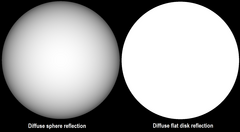
For the hypothetical case of a plane surface, the geometric albedo is the albedo of the surface when the illumination is provided by a beam of radiation that comes in perpendicular to the surface.
In astronomy, the geometric albedo of a celestial body is the ratio of its actual brightness as seen from the light source (i.e. at zero phase angle) to that of an idealized flat, fully reflecting, diffusively scattering (Lambertian) disk with the same cross-section. (This phase angle refers to the direction of the light paths and is not a phase angle in its normal meaning in optics or electronics.)
Diffuse scattering implies that radiation is reflected isotropically with no memory of the location of the incident light source. Zero phase angle corresponds to looking along the direction of illumination. For Earth-bound observers, this occurs when the body in question is at opposition and on the ecliptic.
The visual geometric albedo refers to the geometric albedo quantity when accounting for only electromagnetic radiation in the visible spectrum.
The surface materials (regoliths) of airless bodies (in fact, the majority of bodies in the Solar System) are strongly non-Lambertian and exhibit the opposition effect, which is a strong tendency to reflect light straight back to its source, rather than scattering light diffusely.
The geometric albedo of these bodies can be difficult to determine because of this, as their reflectance is strongly peaked for a small range of phase angles near zero. [1] The strength of this peak differs markedly between bodies, and can only be found by making measurements at small enough phase angles. Such measurements are usually difficult due to the necessary precise placement of the observer very close to the incident light. For example, the Moon is never seen from the Earth at exactly zero phase angle, because then it is being eclipsed. Other Solar System bodies are not in general seen at exactly zero phase angle even at opposition, unless they are also simultaneously located at the ascending or descending node of their orbit, and hence lie on the ecliptic. In practice, measurements at small nonzero phase angles are used to derive the parameters which characterize the directional reflectance properties for the body (Hapke parameters). The reflectance function described by these can then be extrapolated to zero phase angle to obtain an estimate of the geometric albedo.
For very bright, solid, airless objects such as Saturn's moons Enceladus and Tethys, whose total reflectance (Bond albedo) is close to one, a strong opposition effect combines with the high Bond albedo to give them a geometric albedo above unity (1.4 in the case of Enceladus). Light is preferentially reflected straight back to its source even at low angle of incidence such as on the limb or from a slope, whereas a Lambertian surface would scatter the radiation much more broadly. A geometric albedo above unity means that the intensity of light scattered back per unit solid angle towards the source is higher than is possible for any Lambertian surface.
Stars shine intrinsically, but they can also reflect light. In a close binary star system polarimetry can be used to measure the light reflected from one star off another (and vice versa) and therefore also the geometric albedos of the two stars. This task has been accomplished for the two components of the Spica system, with the geometric albedo of Spica A and B being measured as 0.0361 and 0.0136 respectively. [2] The geometric albedos of stars are in general small, for the Sun a value of 0.001 is expected, [3] but for hotter or lower-gravity (i.e. giant) stars the amount of reflected light is expected to be several times that of the stars in the Spica system. [2]

For the hypothetical case of a plane surface, the geometric albedo is the albedo of the surface when the illumination is provided by a beam of radiation that comes in perpendicular to the surface.
The geometric albedo may be greater or smaller than the Bond albedo, depending on surface and atmospheric properties of the body in question. Some examples: [4]
| Name | Bond albedo | Visual geometric albedo | ||
|---|---|---|---|---|
| Mercury [5] [6] | 0.088 | 0.142 | ||
| Venus [7] [6] | 0.76 | 0.689 | ||
| Earth [8] [6] | 0.306 | 0.434 | ||
| Moon [9] | 0.11 | 0.12 | ||
| Mars [10] [6] | 0.25 | 0.17 | ||
| Jupiter [11] [6] | 0.503 | 0.538 | ||
| Saturn [12] [6] | 0.342 | 0.499 | ||
| Enceladus [13] [14] | 0.81 | 1.38 | ||
| Uranus [15] [6] | 0.300 | 0.488 | ||
| Neptune [16] [6] | 0.290 | 0.442 | ||
| Pluto | 0.4 | 0.44–0.61 | ||
| Eris [17] | 0.99 | 0.96 | ||
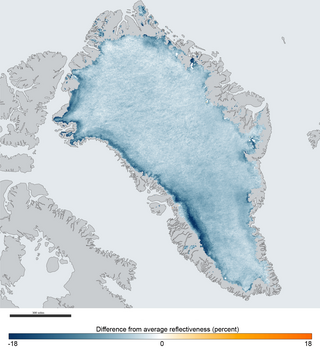
Albedo is the fraction of sunlight that is diffusely reflected by a body. It is measured on a scale from 0 to 1. Surface albedo is defined as the ratio of radiosity Je to the irradiance Ee received by a surface. The proportion reflected is not only determined by properties of the surface itself, but also by the spectral and angular distribution of solar radiation reaching the Earth's surface. These factors vary with atmospheric composition, geographic location, and time.
In astronomy, absolute magnitude is a measure of the luminosity of a celestial object on an inverse logarithmic astronomical magnitude scale. An object's absolute magnitude is defined to be equal to the apparent magnitude that the object would have if it were viewed from a distance of exactly 10 parsecs, without extinction of its light due to absorption by interstellar matter and cosmic dust. By hypothetically placing all objects at a standard reference distance from the observer, their luminosities can be directly compared among each other on a magnitude scale. For Solar System bodies that shine in reflected light, a different definition of absolute magnitude (H) is used, based on a standard reference distance of one astronomical unit.
A trans-Neptunian object (TNO), also written transneptunian object, is any minor planet in the Solar System that orbits the Sun at a greater average distance than Neptune, which has an orbital semi-major axis of 30.1 astronomical units (au).

The reflectance of the surface of a material is its effectiveness in reflecting radiant energy. It is the fraction of incident electromagnetic power that is reflected at the boundary. Reflectance is a component of the response of the electronic structure of the material to the electromagnetic field of light, and is in general a function of the frequency, or wavelength, of the light, its polarization, and the angle of incidence. The dependence of reflectance on the wavelength is called a reflectance spectrum or spectral reflectance curve.

Tethys, or Saturn III, is the fifth-largest moon of Saturn, measuring about 1,060 km (660 mi) across. It was discovered by Giovanni Domenico Cassini in 1684, and is named after the titan Tethys of Greek mythology.

Planetshine is the dim illumination, by sunlight reflected from a planet, of all or part of the otherwise dark side of any moon orbiting the body. Planetlight is the diffuse reflection of sunlight from a planet, whose albedo can be measured.

Enceladus is the sixth-largest moon of Saturn and the 19th-largest in the Solar System. It is about 500 kilometers in diameter, about a tenth of that of Saturn's largest moon, Titan. It is mostly covered by fresh, clean ice, making it one of the most reflective bodies of the Solar System. Consequently, its surface temperature at noon reaches only −198 °C, far colder than a light-absorbing body would be. Despite its small size, Enceladus has a wide variety of surface features, ranging from old, heavily cratered regions to young, tectonically deformed terrain.
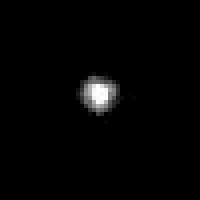
20000 Varuna (provisional designation 2000 WR106) is a large trans-Neptunian object in the Kuiper belt. It was discovered in November 2000 by American astronomer Robert McMillan during a Spacewatch survey at the Kitt Peak National Observatory. It is named after the Hindu deity Varuna, one of the oldest deities mentioned in the Vedic texts.

The moons of Saturn are numerous and diverse, ranging from tiny moonlets only tens of meters across to the enormous Titan, which is larger than the planet Mercury. There are 146 moons with confirmed orbits, the most of any planet in the solar system. This number does not include the many thousands of moonlets embedded within Saturn's dense rings, nor hundreds of possible kilometer-sized distant moons that were seen through telescopes but not recaptured. Seven Saturnian moons are large enough to have collapsed into a relaxed, ellipsoidal shape, though only one or two of those, Titan and possibly Rhea, are currently in hydrostatic equilibrium. Three moons are particularly notable. Titan is the second-largest moon in the Solar System, with a nitrogen-rich Earth-like atmosphere and a landscape featuring river networks and hydrocarbon lakes. Enceladus emits jets of ice from its south-polar region and is covered in a deep layer of snow. Iapetus has contrasting black and white hemispheres as well as an extensive ridge of equatorial mountains among the tallest in the solar system.

The planet Neptune has 16 known moons, which are named for minor water deities and a water creature in Greek mythology. By far the largest of them is Triton, discovered by William Lassell on October 10, 1846, 17 days after the discovery of Neptune itself. Over a century passed before the discovery of the second natural satellite, Nereid, in 1949, and another 40 years passed before Proteus, Neptune's second-largest moon, was discovered in 1989.

The rings of Uranus are intermediate in complexity between the more extensive set around Saturn and the simpler systems around Jupiter and Neptune. The rings of Uranus were discovered on March 10, 1977, by James L. Elliot, Edward W. Dunham, and Jessica Mink. William Herschel had also reported observing rings in 1789; modern astronomers are divided on whether he could have seen them, as they are very dark and faint.

The bidirectional reflectance distribution function (BRDF), symbol , is a function of four real variables that defines how light from a source is reflected off an opaque surface. It is employed in the optics of real-world light, in computer graphics algorithms, and in computer vision algorithms. The function takes an incoming light direction, , and outgoing direction, , and returns the ratio of reflected radiance exiting along to the irradiance incident on the surface from direction . Each direction is itself parameterized by azimuth angle and zenith angle , therefore the BRDF as a whole is a function of 4 variables. The BRDF has units sr−1, with steradians (sr) being a unit of solid angle.
For most numbered asteroids, almost nothing is known apart from a few physical parameters and orbital elements. Some physical characteristics can only be estimated. The physical data is determined by making certain standard assumptions.
The Bond albedo, named after the American astronomer George Phillips Bond (1825–1865), who originally proposed it, is the fraction of power in the total electromagnetic radiation incident on an astronomical body that is scattered back out into space.
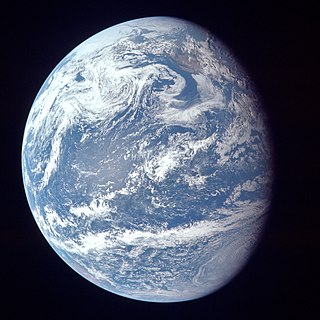
An ocean world, ocean planet or water world is a type of planet that contains a substantial amount of water in the form of oceans, as part of its hydrosphere, either beneath the surface, as subsurface oceans, or on the surface, potentially submerging all dry land. The term ocean world is also used sometimes for astronomical bodies with an ocean composed of a different fluid or thalassogen, such as lava, ammonia or hydrocarbons. The study of extraterrestrial oceans is referred to as planetary oceanography.
The Hapke parameters are a set of parameters for an empirical model that is commonly used to describe the directional reflectance properties of the airless regolith surfaces of bodies in the Solar System. The model has been developed by astronomer Bruce Hapke at the University of Pittsburgh.

The opposition surge is the brightening of a rough surface, or an object with many particles, when illuminated from directly behind the observer. The term is most widely used in astronomy, where generally it refers to the sudden noticeable increase in the brightness of a celestial body such as a planet, moon, or comet as its phase angle of observation approaches zero. It is so named because the reflected light from the Moon and Mars appear significantly brighter than predicted by simple Lambertian reflectance when at astronomical opposition. Two physical mechanisms have been proposed for this observational phenomenon: shadow hiding and coherent backscatter.
In astronomy, a phase curve describes the brightness of a reflecting body as a function of its phase angle. The brightness usually refers the object's absolute magnitude, which, in turn, is its apparent magnitude at a distance of one astronomical unit from the Earth and Sun.
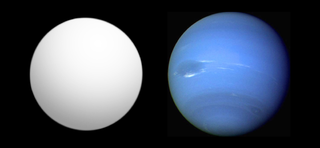
Kepler-11g is an exoplanet discovered in the orbit of the sunlike star Kepler-11 by the Kepler spacecraft, a NASA satellite tasked with searching for terrestrial planets. Kepler-11g is the outermost of the star's six planets. The planet orbits at a distance of nearly half the mean distance between Earth and the Sun. It completes an orbit every 118 days, placing it much further from its star than the system's inner five planets. Its estimated radius is a little over three times that of Earth, i.e. comparable to Neptune's size. Kepler-11g's distance from the inner planets made its confirmation more difficult than that of the inner planets, as scientists had to work to exhaustively disprove all reasonable alternatives before Kepler-11g could be confirmed. The planet's discovery, along with that of the other Kepler-11 planets, was announced on February 2, 2011. According to NASA, the Kepler-11 planets form the flattest and most compact system yet discovered.
The planetary equilibrium temperature is a theoretical temperature that a planet would be if it were in radiative equilibrium, typically under the assumption that it radiates as a black body being heated only by its parent star. In this model, the presence or absence of an atmosphere is irrelevant, as the equilibrium temperature is calculated purely from a balance with incident stellar energy.